MBA503 Operations Management Report: Toyota Motor Corporation Analysis
VerifiedAdded on 2023/01/05
|12
|3189
|51
Report
AI Summary
This report provides a comprehensive analysis of Toyota Motor Corporation's operations management. It begins with an introduction to the company, its history, and its diverse product lines. The report delves into Toyota's operation management department, focusing on its strategies, including the elimination of waste and the adoption of the Toyota Way. It examines the decision-making processes, emphasizing innovation and corporate social responsibility. The report explores product and process design, including the Toyota Production System (TPS) and the 5S principles. It also analyzes the company's integrated value chain, from suppliers to customers, and discusses planning, control, and forecasting of demand. The report highlights areas for improvement, such as communication channels and customer relations, and concludes with an overview of Toyota's approach to continuous improvement in its operations.
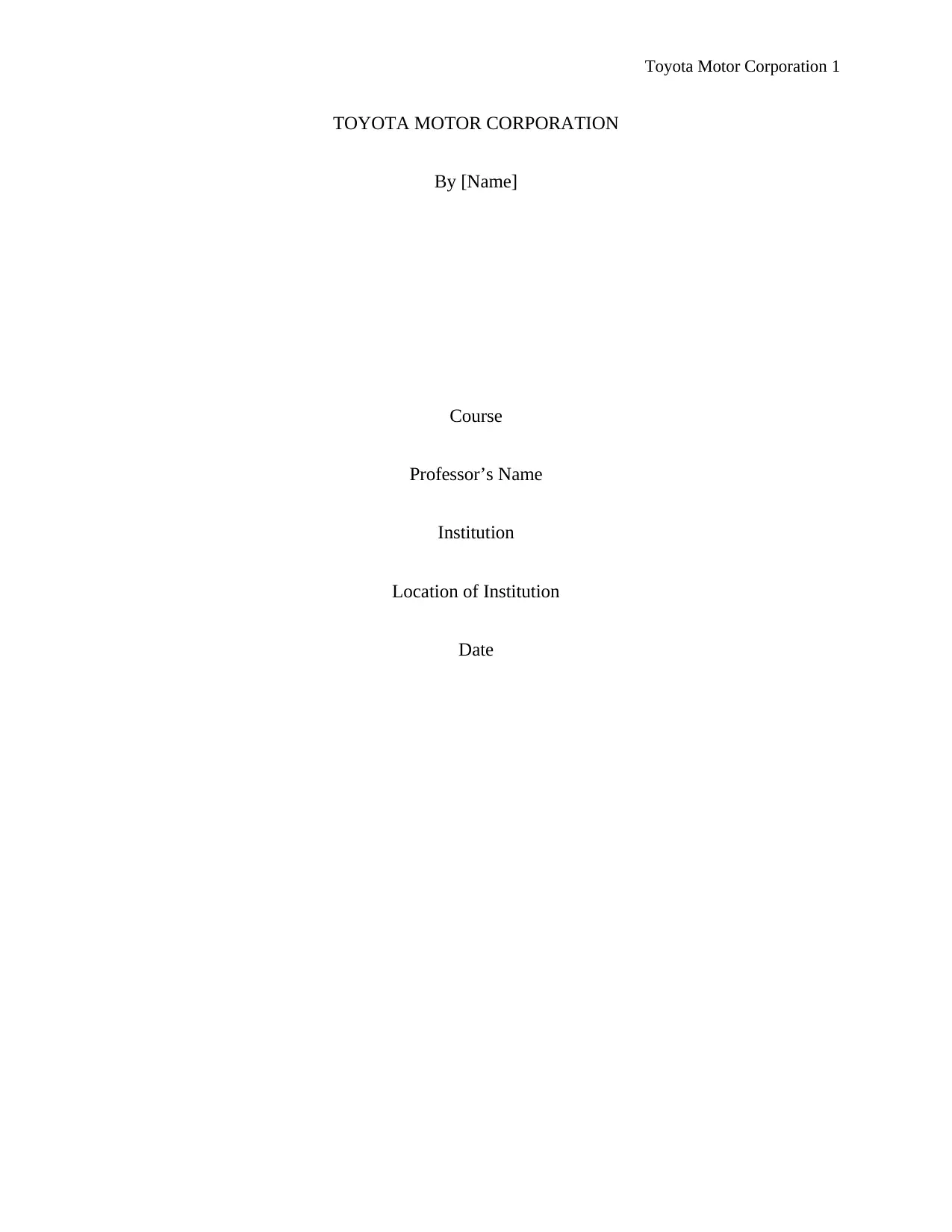
Toyota Motor Corporation 1
TOYOTA MOTOR CORPORATION
By [Name]
Course
Professor’s Name
Institution
Location of Institution
Date
TOYOTA MOTOR CORPORATION
By [Name]
Course
Professor’s Name
Institution
Location of Institution
Date
Paraphrase This Document
Need a fresh take? Get an instant paraphrase of this document with our AI Paraphraser
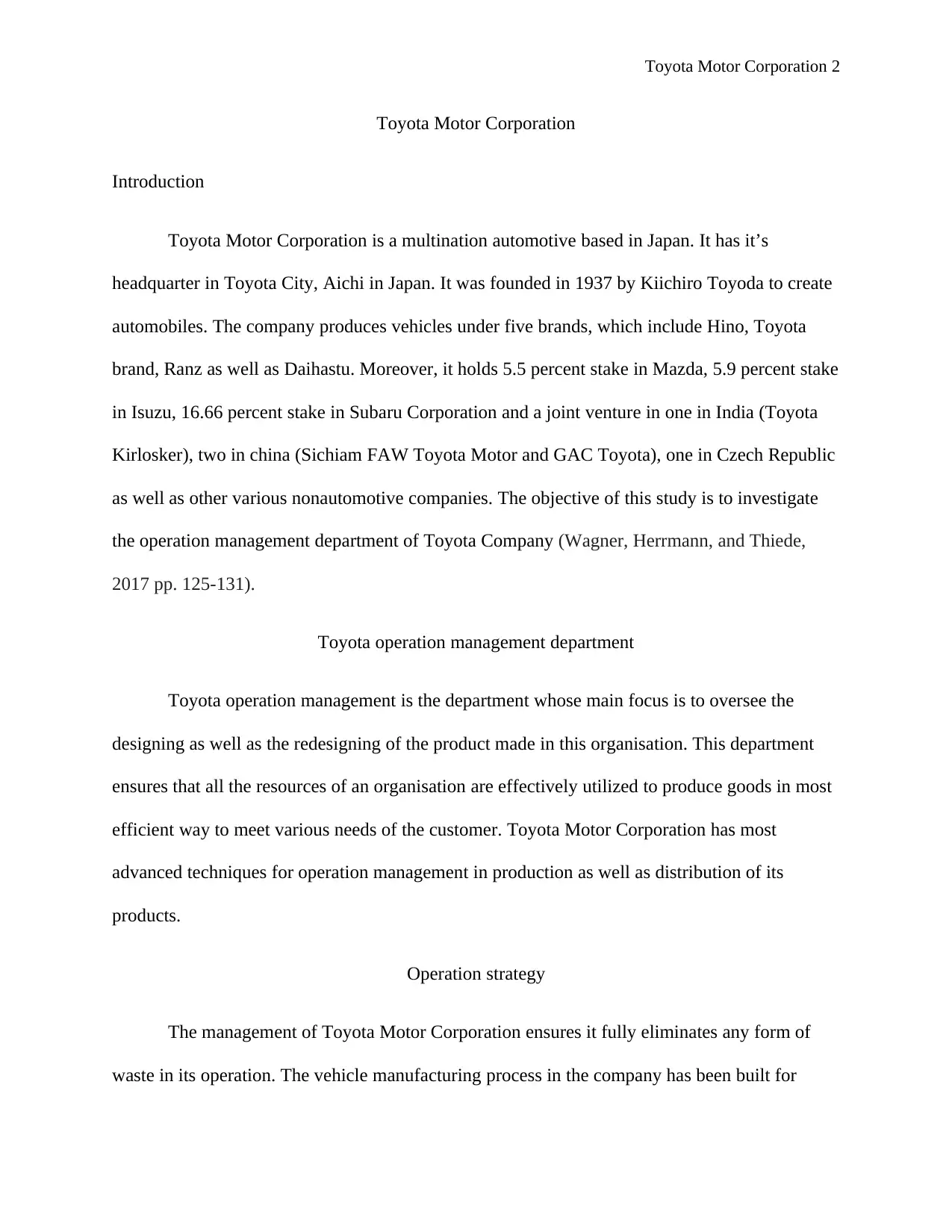
Toyota Motor Corporation 2
Toyota Motor Corporation
Introduction
Toyota Motor Corporation is a multination automotive based in Japan. It has it’s
headquarter in Toyota City, Aichi in Japan. It was founded in 1937 by Kiichiro Toyoda to create
automobiles. The company produces vehicles under five brands, which include Hino, Toyota
brand, Ranz as well as Daihastu. Moreover, it holds 5.5 percent stake in Mazda, 5.9 percent stake
in Isuzu, 16.66 percent stake in Subaru Corporation and a joint venture in one in India (Toyota
Kirlosker), two in china (Sichiam FAW Toyota Motor and GAC Toyota), one in Czech Republic
as well as other various nonautomotive companies. The objective of this study is to investigate
the operation management department of Toyota Company (Wagner, Herrmann, and Thiede,
2017 pp. 125-131).
Toyota operation management department
Toyota operation management is the department whose main focus is to oversee the
designing as well as the redesigning of the product made in this organisation. This department
ensures that all the resources of an organisation are effectively utilized to produce goods in most
efficient way to meet various needs of the customer. Toyota Motor Corporation has most
advanced techniques for operation management in production as well as distribution of its
products.
Operation strategy
The management of Toyota Motor Corporation ensures it fully eliminates any form of
waste in its operation. The vehicle manufacturing process in the company has been built for
Toyota Motor Corporation
Introduction
Toyota Motor Corporation is a multination automotive based in Japan. It has it’s
headquarter in Toyota City, Aichi in Japan. It was founded in 1937 by Kiichiro Toyoda to create
automobiles. The company produces vehicles under five brands, which include Hino, Toyota
brand, Ranz as well as Daihastu. Moreover, it holds 5.5 percent stake in Mazda, 5.9 percent stake
in Isuzu, 16.66 percent stake in Subaru Corporation and a joint venture in one in India (Toyota
Kirlosker), two in china (Sichiam FAW Toyota Motor and GAC Toyota), one in Czech Republic
as well as other various nonautomotive companies. The objective of this study is to investigate
the operation management department of Toyota Company (Wagner, Herrmann, and Thiede,
2017 pp. 125-131).
Toyota operation management department
Toyota operation management is the department whose main focus is to oversee the
designing as well as the redesigning of the product made in this organisation. This department
ensures that all the resources of an organisation are effectively utilized to produce goods in most
efficient way to meet various needs of the customer. Toyota Motor Corporation has most
advanced techniques for operation management in production as well as distribution of its
products.
Operation strategy
The management of Toyota Motor Corporation ensures it fully eliminates any form of
waste in its operation. The vehicle manufacturing process in the company has been built for
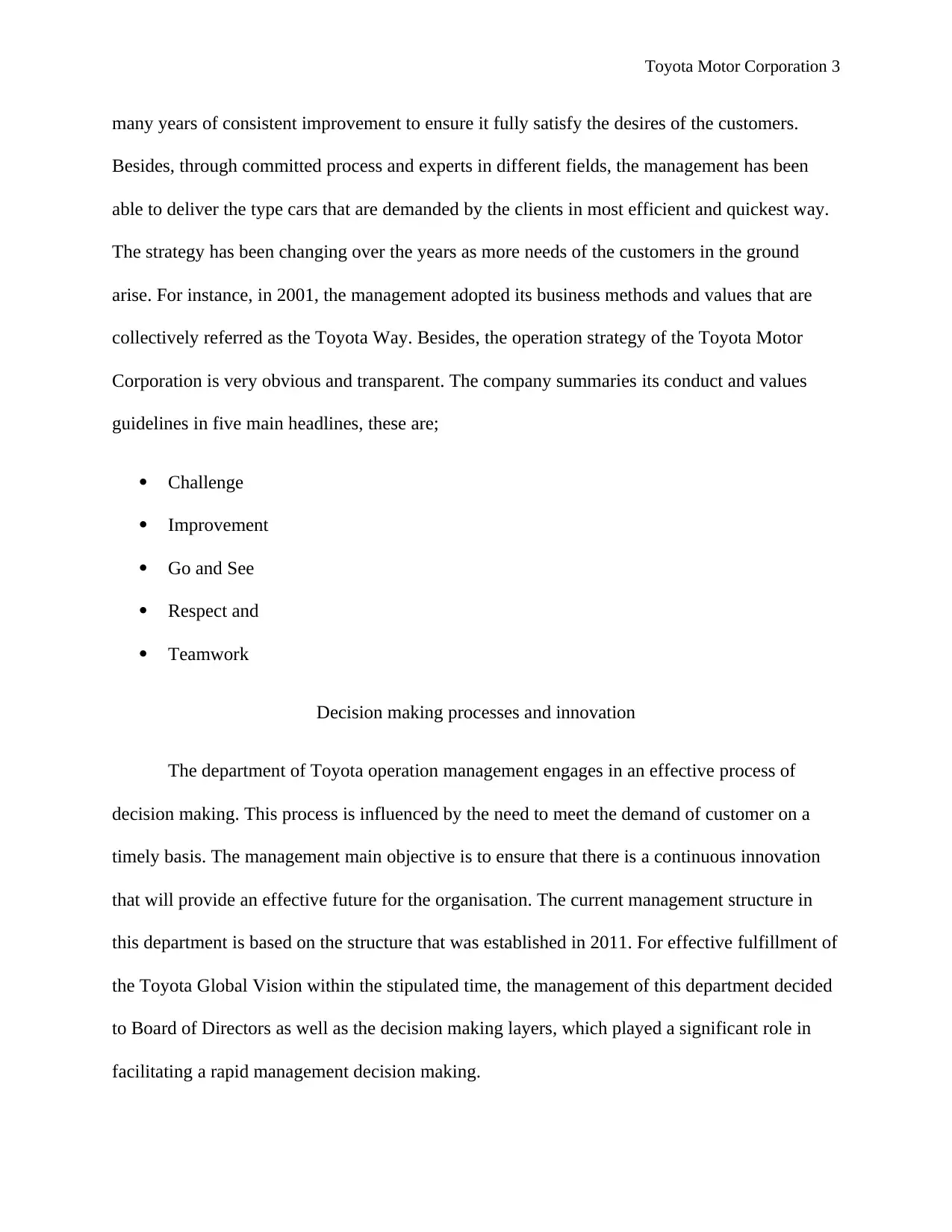
Toyota Motor Corporation 3
many years of consistent improvement to ensure it fully satisfy the desires of the customers.
Besides, through committed process and experts in different fields, the management has been
able to deliver the type cars that are demanded by the clients in most efficient and quickest way.
The strategy has been changing over the years as more needs of the customers in the ground
arise. For instance, in 2001, the management adopted its business methods and values that are
collectively referred as the Toyota Way. Besides, the operation strategy of the Toyota Motor
Corporation is very obvious and transparent. The company summaries its conduct and values
guidelines in five main headlines, these are;
Challenge
Improvement
Go and See
Respect and
Teamwork
Decision making processes and innovation
The department of Toyota operation management engages in an effective process of
decision making. This process is influenced by the need to meet the demand of customer on a
timely basis. The management main objective is to ensure that there is a continuous innovation
that will provide an effective future for the organisation. The current management structure in
this department is based on the structure that was established in 2011. For effective fulfillment of
the Toyota Global Vision within the stipulated time, the management of this department decided
to Board of Directors as well as the decision making layers, which played a significant role in
facilitating a rapid management decision making.
many years of consistent improvement to ensure it fully satisfy the desires of the customers.
Besides, through committed process and experts in different fields, the management has been
able to deliver the type cars that are demanded by the clients in most efficient and quickest way.
The strategy has been changing over the years as more needs of the customers in the ground
arise. For instance, in 2001, the management adopted its business methods and values that are
collectively referred as the Toyota Way. Besides, the operation strategy of the Toyota Motor
Corporation is very obvious and transparent. The company summaries its conduct and values
guidelines in five main headlines, these are;
Challenge
Improvement
Go and See
Respect and
Teamwork
Decision making processes and innovation
The department of Toyota operation management engages in an effective process of
decision making. This process is influenced by the need to meet the demand of customer on a
timely basis. The management main objective is to ensure that there is a continuous innovation
that will provide an effective future for the organisation. The current management structure in
this department is based on the structure that was established in 2011. For effective fulfillment of
the Toyota Global Vision within the stipulated time, the management of this department decided
to Board of Directors as well as the decision making layers, which played a significant role in
facilitating a rapid management decision making.
⊘ This is a preview!⊘
Do you want full access?
Subscribe today to unlock all pages.

Trusted by 1+ million students worldwide
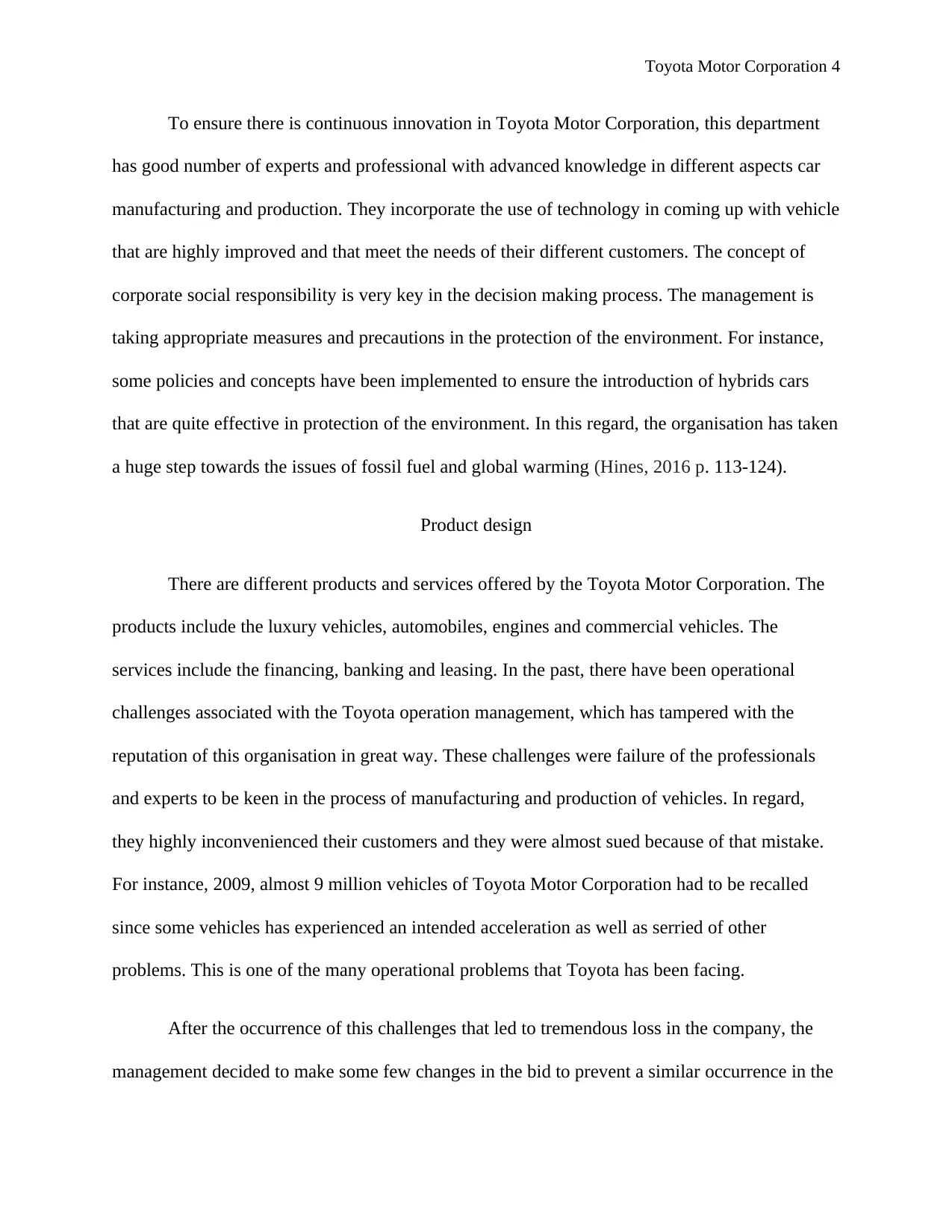
Toyota Motor Corporation 4
To ensure there is continuous innovation in Toyota Motor Corporation, this department
has good number of experts and professional with advanced knowledge in different aspects car
manufacturing and production. They incorporate the use of technology in coming up with vehicle
that are highly improved and that meet the needs of their different customers. The concept of
corporate social responsibility is very key in the decision making process. The management is
taking appropriate measures and precautions in the protection of the environment. For instance,
some policies and concepts have been implemented to ensure the introduction of hybrids cars
that are quite effective in protection of the environment. In this regard, the organisation has taken
a huge step towards the issues of fossil fuel and global warming (Hines, 2016 p. 113-124).
Product design
There are different products and services offered by the Toyota Motor Corporation. The
products include the luxury vehicles, automobiles, engines and commercial vehicles. The
services include the financing, banking and leasing. In the past, there have been operational
challenges associated with the Toyota operation management, which has tampered with the
reputation of this organisation in great way. These challenges were failure of the professionals
and experts to be keen in the process of manufacturing and production of vehicles. In regard,
they highly inconvenienced their customers and they were almost sued because of that mistake.
For instance, 2009, almost 9 million vehicles of Toyota Motor Corporation had to be recalled
since some vehicles has experienced an intended acceleration as well as serried of other
problems. This is one of the many operational problems that Toyota has been facing.
After the occurrence of this challenges that led to tremendous loss in the company, the
management decided to make some few changes in the bid to prevent a similar occurrence in the
To ensure there is continuous innovation in Toyota Motor Corporation, this department
has good number of experts and professional with advanced knowledge in different aspects car
manufacturing and production. They incorporate the use of technology in coming up with vehicle
that are highly improved and that meet the needs of their different customers. The concept of
corporate social responsibility is very key in the decision making process. The management is
taking appropriate measures and precautions in the protection of the environment. For instance,
some policies and concepts have been implemented to ensure the introduction of hybrids cars
that are quite effective in protection of the environment. In this regard, the organisation has taken
a huge step towards the issues of fossil fuel and global warming (Hines, 2016 p. 113-124).
Product design
There are different products and services offered by the Toyota Motor Corporation. The
products include the luxury vehicles, automobiles, engines and commercial vehicles. The
services include the financing, banking and leasing. In the past, there have been operational
challenges associated with the Toyota operation management, which has tampered with the
reputation of this organisation in great way. These challenges were failure of the professionals
and experts to be keen in the process of manufacturing and production of vehicles. In regard,
they highly inconvenienced their customers and they were almost sued because of that mistake.
For instance, 2009, almost 9 million vehicles of Toyota Motor Corporation had to be recalled
since some vehicles has experienced an intended acceleration as well as serried of other
problems. This is one of the many operational problems that Toyota has been facing.
After the occurrence of this challenges that led to tremendous loss in the company, the
management decided to make some few changes in the bid to prevent a similar occurrence in the
Paraphrase This Document
Need a fresh take? Get an instant paraphrase of this document with our AI Paraphraser
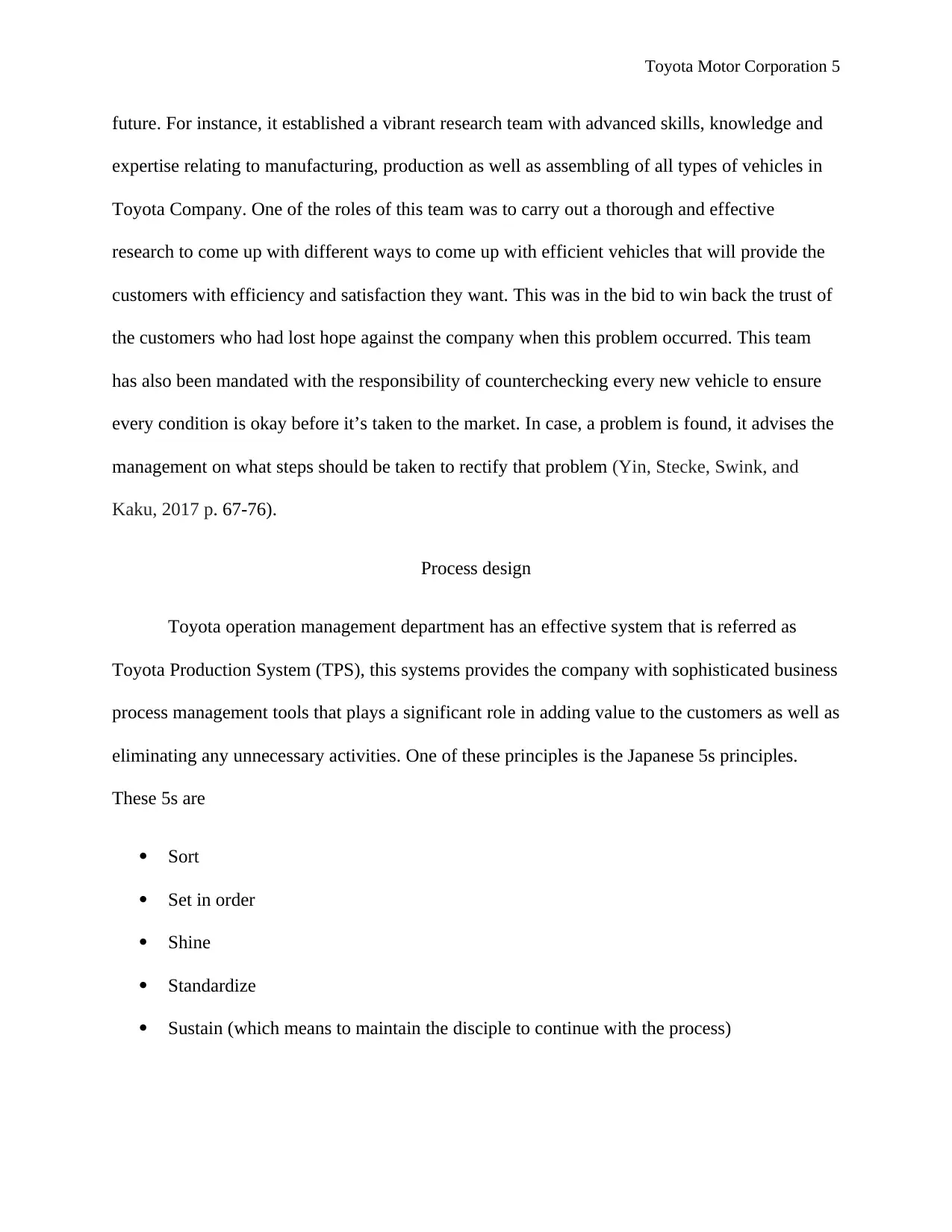
Toyota Motor Corporation 5
future. For instance, it established a vibrant research team with advanced skills, knowledge and
expertise relating to manufacturing, production as well as assembling of all types of vehicles in
Toyota Company. One of the roles of this team was to carry out a thorough and effective
research to come up with different ways to come up with efficient vehicles that will provide the
customers with efficiency and satisfaction they want. This was in the bid to win back the trust of
the customers who had lost hope against the company when this problem occurred. This team
has also been mandated with the responsibility of counterchecking every new vehicle to ensure
every condition is okay before it’s taken to the market. In case, a problem is found, it advises the
management on what steps should be taken to rectify that problem (Yin, Stecke, Swink, and
Kaku, 2017 p. 67-76).
Process design
Toyota operation management department has an effective system that is referred as
Toyota Production System (TPS), this systems provides the company with sophisticated business
process management tools that plays a significant role in adding value to the customers as well as
eliminating any unnecessary activities. One of these principles is the Japanese 5s principles.
These 5s are
Sort
Set in order
Shine
Standardize
Sustain (which means to maintain the disciple to continue with the process)
future. For instance, it established a vibrant research team with advanced skills, knowledge and
expertise relating to manufacturing, production as well as assembling of all types of vehicles in
Toyota Company. One of the roles of this team was to carry out a thorough and effective
research to come up with different ways to come up with efficient vehicles that will provide the
customers with efficiency and satisfaction they want. This was in the bid to win back the trust of
the customers who had lost hope against the company when this problem occurred. This team
has also been mandated with the responsibility of counterchecking every new vehicle to ensure
every condition is okay before it’s taken to the market. In case, a problem is found, it advises the
management on what steps should be taken to rectify that problem (Yin, Stecke, Swink, and
Kaku, 2017 p. 67-76).
Process design
Toyota operation management department has an effective system that is referred as
Toyota Production System (TPS), this systems provides the company with sophisticated business
process management tools that plays a significant role in adding value to the customers as well as
eliminating any unnecessary activities. One of these principles is the Japanese 5s principles.
These 5s are
Sort
Set in order
Shine
Standardize
Sustain (which means to maintain the disciple to continue with the process)
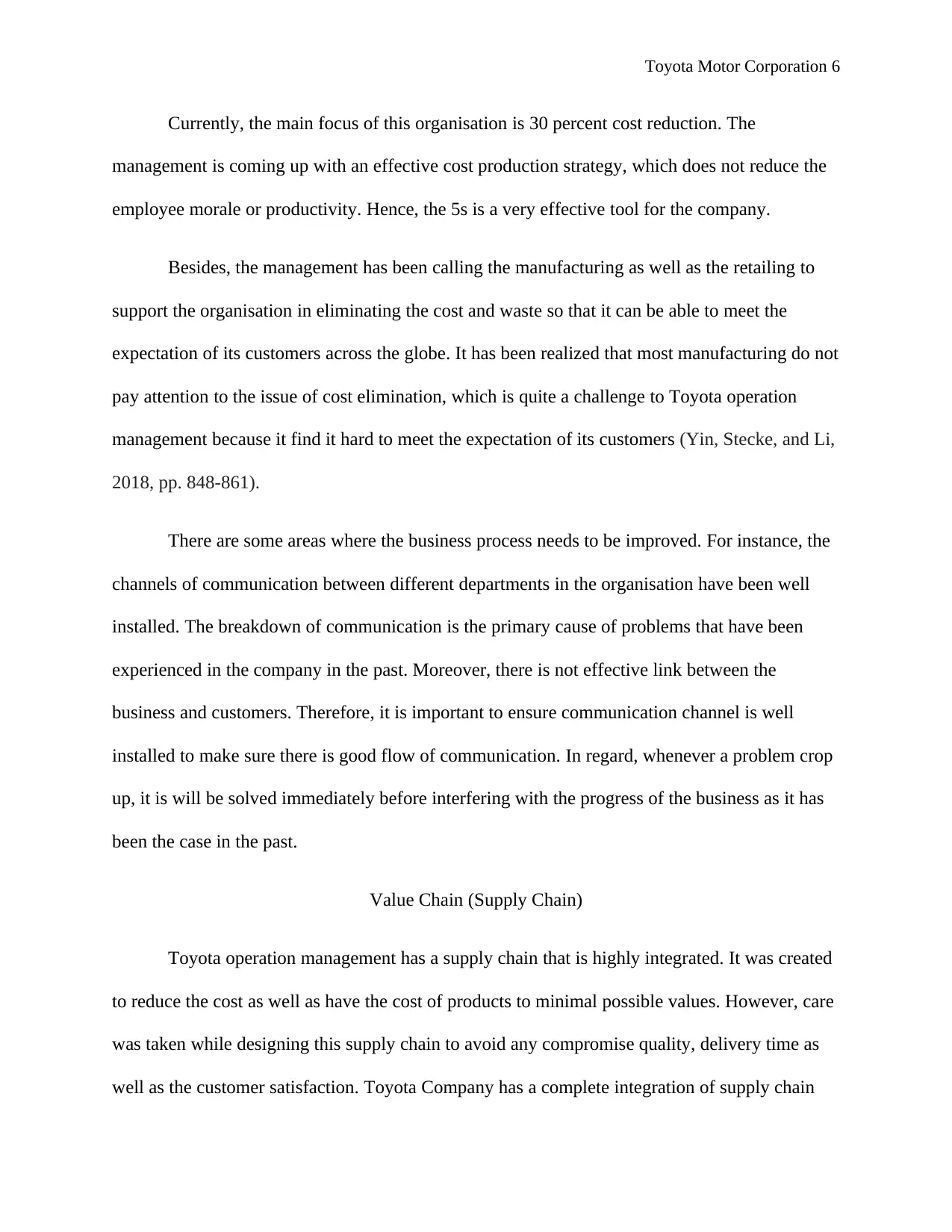
Toyota Motor Corporation 6
Currently, the main focus of this organisation is 30 percent cost reduction. The
management is coming up with an effective cost production strategy, which does not reduce the
employee morale or productivity. Hence, the 5s is a very effective tool for the company.
Besides, the management has been calling the manufacturing as well as the retailing to
support the organisation in eliminating the cost and waste so that it can be able to meet the
expectation of its customers across the globe. It has been realized that most manufacturing do not
pay attention to the issue of cost elimination, which is quite a challenge to Toyota operation
management because it find it hard to meet the expectation of its customers (Yin, Stecke, and Li,
2018, pp. 848-861).
There are some areas where the business process needs to be improved. For instance, the
channels of communication between different departments in the organisation have been well
installed. The breakdown of communication is the primary cause of problems that have been
experienced in the company in the past. Moreover, there is not effective link between the
business and customers. Therefore, it is important to ensure communication channel is well
installed to make sure there is good flow of communication. In regard, whenever a problem crop
up, it is will be solved immediately before interfering with the progress of the business as it has
been the case in the past.
Value Chain (Supply Chain)
Toyota operation management has a supply chain that is highly integrated. It was created
to reduce the cost as well as have the cost of products to minimal possible values. However, care
was taken while designing this supply chain to avoid any compromise quality, delivery time as
well as the customer satisfaction. Toyota Company has a complete integration of supply chain
Currently, the main focus of this organisation is 30 percent cost reduction. The
management is coming up with an effective cost production strategy, which does not reduce the
employee morale or productivity. Hence, the 5s is a very effective tool for the company.
Besides, the management has been calling the manufacturing as well as the retailing to
support the organisation in eliminating the cost and waste so that it can be able to meet the
expectation of its customers across the globe. It has been realized that most manufacturing do not
pay attention to the issue of cost elimination, which is quite a challenge to Toyota operation
management because it find it hard to meet the expectation of its customers (Yin, Stecke, and Li,
2018, pp. 848-861).
There are some areas where the business process needs to be improved. For instance, the
channels of communication between different departments in the organisation have been well
installed. The breakdown of communication is the primary cause of problems that have been
experienced in the company in the past. Moreover, there is not effective link between the
business and customers. Therefore, it is important to ensure communication channel is well
installed to make sure there is good flow of communication. In regard, whenever a problem crop
up, it is will be solved immediately before interfering with the progress of the business as it has
been the case in the past.
Value Chain (Supply Chain)
Toyota operation management has a supply chain that is highly integrated. It was created
to reduce the cost as well as have the cost of products to minimal possible values. However, care
was taken while designing this supply chain to avoid any compromise quality, delivery time as
well as the customer satisfaction. Toyota Company has a complete integration of supply chain
⊘ This is a preview!⊘
Do you want full access?
Subscribe today to unlock all pages.

Trusted by 1+ million students worldwide
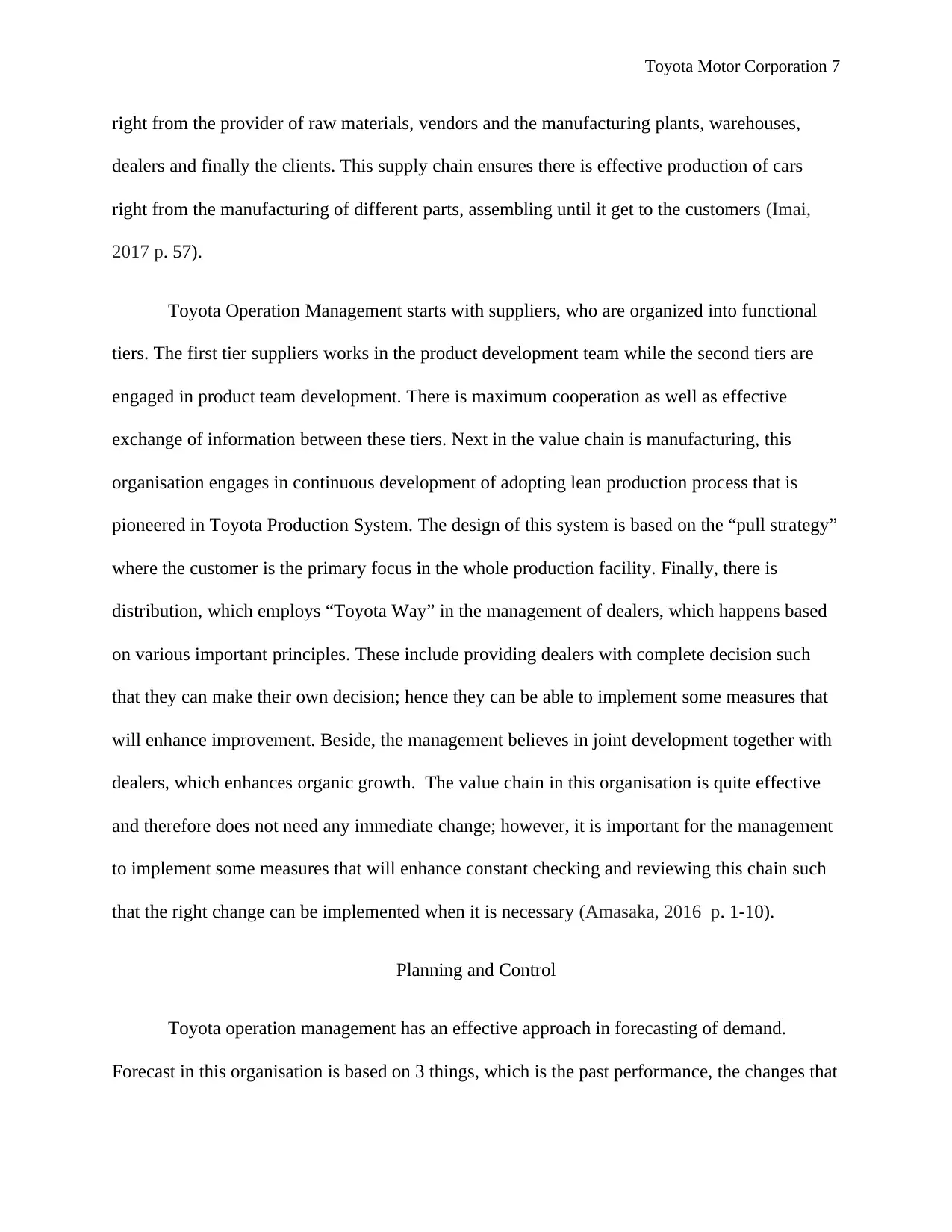
Toyota Motor Corporation 7
right from the provider of raw materials, vendors and the manufacturing plants, warehouses,
dealers and finally the clients. This supply chain ensures there is effective production of cars
right from the manufacturing of different parts, assembling until it get to the customers (Imai,
2017 p. 57).
Toyota Operation Management starts with suppliers, who are organized into functional
tiers. The first tier suppliers works in the product development team while the second tiers are
engaged in product team development. There is maximum cooperation as well as effective
exchange of information between these tiers. Next in the value chain is manufacturing, this
organisation engages in continuous development of adopting lean production process that is
pioneered in Toyota Production System. The design of this system is based on the “pull strategy”
where the customer is the primary focus in the whole production facility. Finally, there is
distribution, which employs “Toyota Way” in the management of dealers, which happens based
on various important principles. These include providing dealers with complete decision such
that they can make their own decision; hence they can be able to implement some measures that
will enhance improvement. Beside, the management believes in joint development together with
dealers, which enhances organic growth. The value chain in this organisation is quite effective
and therefore does not need any immediate change; however, it is important for the management
to implement some measures that will enhance constant checking and reviewing this chain such
that the right change can be implemented when it is necessary (Amasaka, 2016 p. 1-10).
Planning and Control
Toyota operation management has an effective approach in forecasting of demand.
Forecast in this organisation is based on 3 things, which is the past performance, the changes that
right from the provider of raw materials, vendors and the manufacturing plants, warehouses,
dealers and finally the clients. This supply chain ensures there is effective production of cars
right from the manufacturing of different parts, assembling until it get to the customers (Imai,
2017 p. 57).
Toyota Operation Management starts with suppliers, who are organized into functional
tiers. The first tier suppliers works in the product development team while the second tiers are
engaged in product team development. There is maximum cooperation as well as effective
exchange of information between these tiers. Next in the value chain is manufacturing, this
organisation engages in continuous development of adopting lean production process that is
pioneered in Toyota Production System. The design of this system is based on the “pull strategy”
where the customer is the primary focus in the whole production facility. Finally, there is
distribution, which employs “Toyota Way” in the management of dealers, which happens based
on various important principles. These include providing dealers with complete decision such
that they can make their own decision; hence they can be able to implement some measures that
will enhance improvement. Beside, the management believes in joint development together with
dealers, which enhances organic growth. The value chain in this organisation is quite effective
and therefore does not need any immediate change; however, it is important for the management
to implement some measures that will enhance constant checking and reviewing this chain such
that the right change can be implemented when it is necessary (Amasaka, 2016 p. 1-10).
Planning and Control
Toyota operation management has an effective approach in forecasting of demand.
Forecast in this organisation is based on 3 things, which is the past performance, the changes that
Paraphrase This Document
Need a fresh take? Get an instant paraphrase of this document with our AI Paraphraser
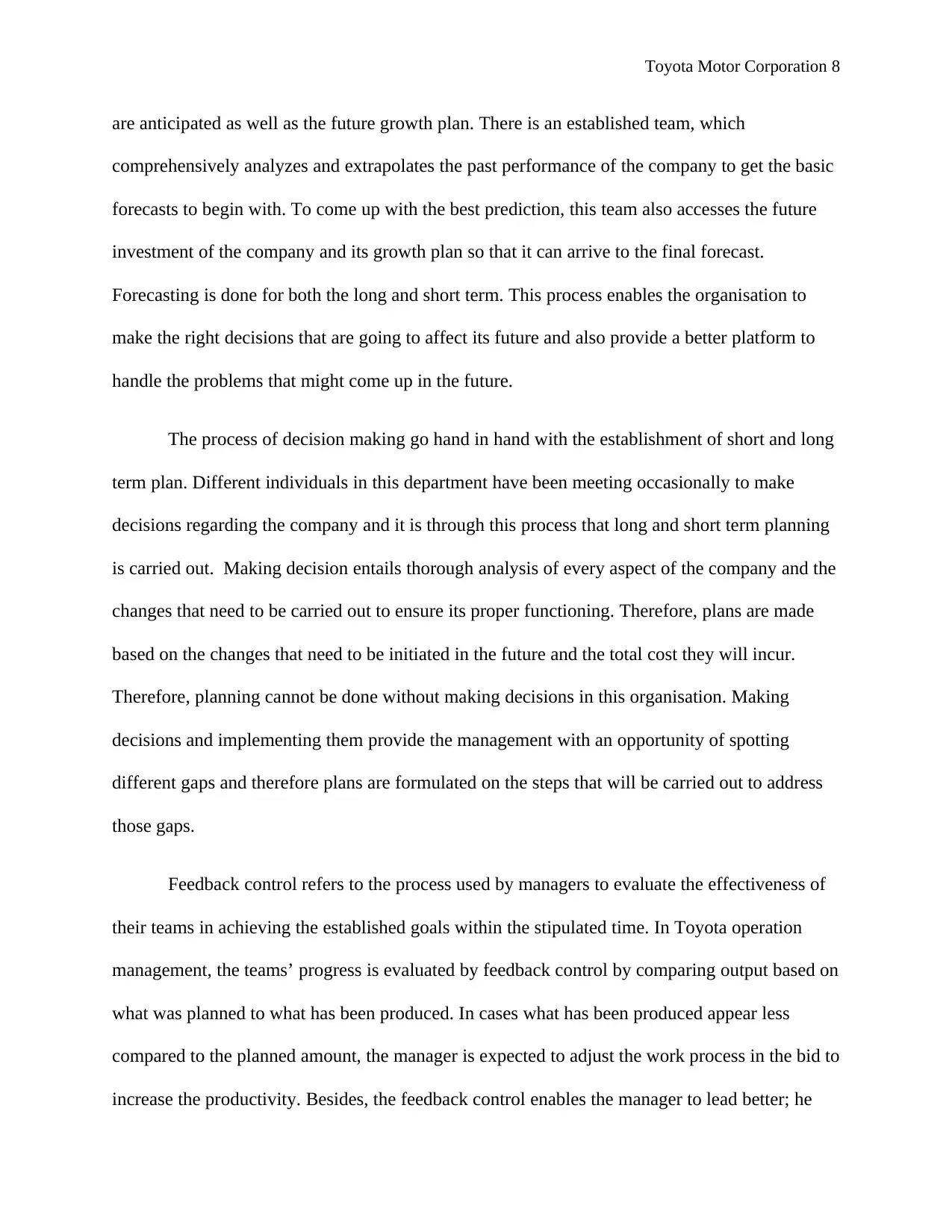
Toyota Motor Corporation 8
are anticipated as well as the future growth plan. There is an established team, which
comprehensively analyzes and extrapolates the past performance of the company to get the basic
forecasts to begin with. To come up with the best prediction, this team also accesses the future
investment of the company and its growth plan so that it can arrive to the final forecast.
Forecasting is done for both the long and short term. This process enables the organisation to
make the right decisions that are going to affect its future and also provide a better platform to
handle the problems that might come up in the future.
The process of decision making go hand in hand with the establishment of short and long
term plan. Different individuals in this department have been meeting occasionally to make
decisions regarding the company and it is through this process that long and short term planning
is carried out. Making decision entails thorough analysis of every aspect of the company and the
changes that need to be carried out to ensure its proper functioning. Therefore, plans are made
based on the changes that need to be initiated in the future and the total cost they will incur.
Therefore, planning cannot be done without making decisions in this organisation. Making
decisions and implementing them provide the management with an opportunity of spotting
different gaps and therefore plans are formulated on the steps that will be carried out to address
those gaps.
Feedback control refers to the process used by managers to evaluate the effectiveness of
their teams in achieving the established goals within the stipulated time. In Toyota operation
management, the teams’ progress is evaluated by feedback control by comparing output based on
what was planned to what has been produced. In cases what has been produced appear less
compared to the planned amount, the manager is expected to adjust the work process in the bid to
increase the productivity. Besides, the feedback control enables the manager to lead better; he
are anticipated as well as the future growth plan. There is an established team, which
comprehensively analyzes and extrapolates the past performance of the company to get the basic
forecasts to begin with. To come up with the best prediction, this team also accesses the future
investment of the company and its growth plan so that it can arrive to the final forecast.
Forecasting is done for both the long and short term. This process enables the organisation to
make the right decisions that are going to affect its future and also provide a better platform to
handle the problems that might come up in the future.
The process of decision making go hand in hand with the establishment of short and long
term plan. Different individuals in this department have been meeting occasionally to make
decisions regarding the company and it is through this process that long and short term planning
is carried out. Making decision entails thorough analysis of every aspect of the company and the
changes that need to be carried out to ensure its proper functioning. Therefore, plans are made
based on the changes that need to be initiated in the future and the total cost they will incur.
Therefore, planning cannot be done without making decisions in this organisation. Making
decisions and implementing them provide the management with an opportunity of spotting
different gaps and therefore plans are formulated on the steps that will be carried out to address
those gaps.
Feedback control refers to the process used by managers to evaluate the effectiveness of
their teams in achieving the established goals within the stipulated time. In Toyota operation
management, the teams’ progress is evaluated by feedback control by comparing output based on
what was planned to what has been produced. In cases what has been produced appear less
compared to the planned amount, the manager is expected to adjust the work process in the bid to
increase the productivity. Besides, the feedback control enables the manager to lead better; he
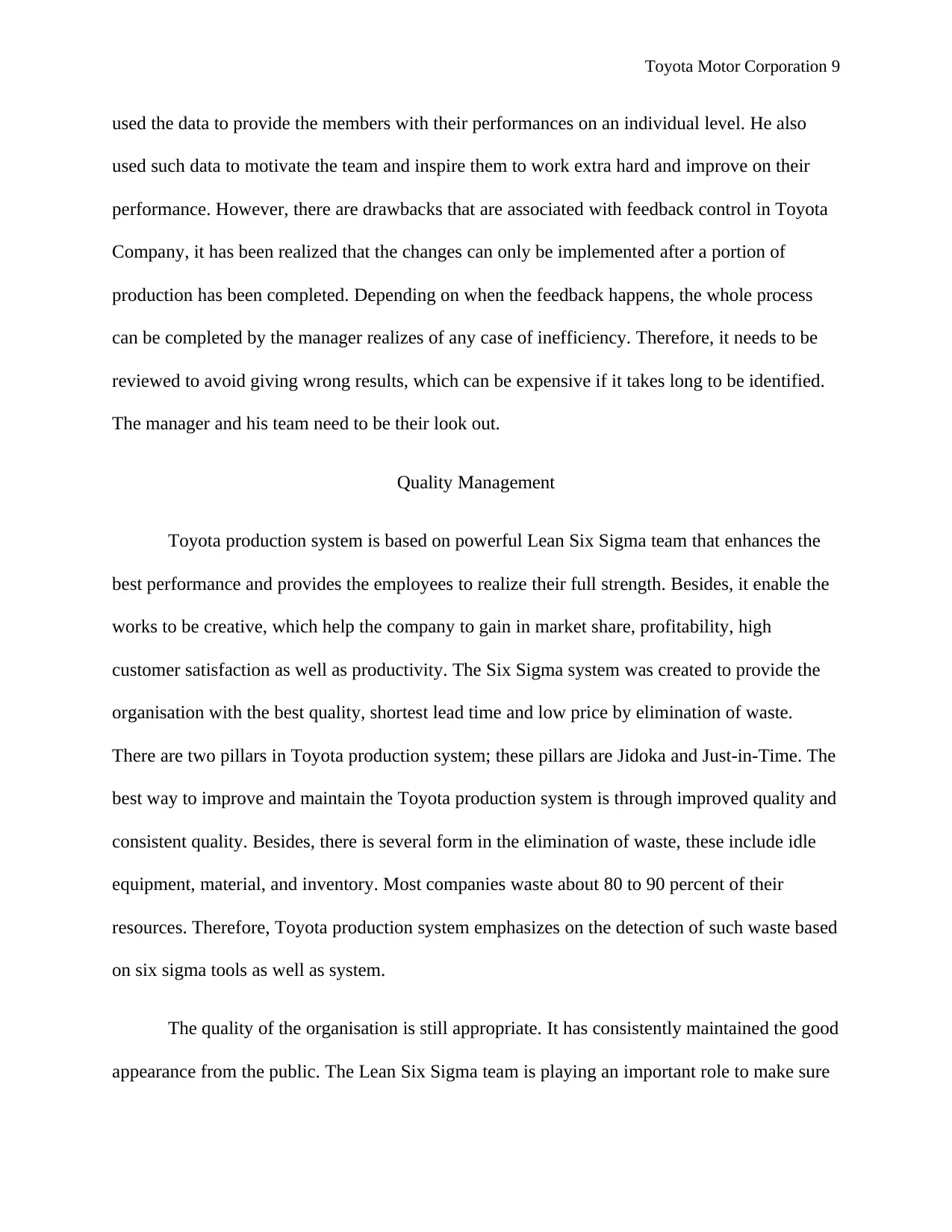
Toyota Motor Corporation 9
used the data to provide the members with their performances on an individual level. He also
used such data to motivate the team and inspire them to work extra hard and improve on their
performance. However, there are drawbacks that are associated with feedback control in Toyota
Company, it has been realized that the changes can only be implemented after a portion of
production has been completed. Depending on when the feedback happens, the whole process
can be completed by the manager realizes of any case of inefficiency. Therefore, it needs to be
reviewed to avoid giving wrong results, which can be expensive if it takes long to be identified.
The manager and his team need to be their look out.
Quality Management
Toyota production system is based on powerful Lean Six Sigma team that enhances the
best performance and provides the employees to realize their full strength. Besides, it enable the
works to be creative, which help the company to gain in market share, profitability, high
customer satisfaction as well as productivity. The Six Sigma system was created to provide the
organisation with the best quality, shortest lead time and low price by elimination of waste.
There are two pillars in Toyota production system; these pillars are Jidoka and Just-in-Time. The
best way to improve and maintain the Toyota production system is through improved quality and
consistent quality. Besides, there is several form in the elimination of waste, these include idle
equipment, material, and inventory. Most companies waste about 80 to 90 percent of their
resources. Therefore, Toyota production system emphasizes on the detection of such waste based
on six sigma tools as well as system.
The quality of the organisation is still appropriate. It has consistently maintained the good
appearance from the public. The Lean Six Sigma team is playing an important role to make sure
used the data to provide the members with their performances on an individual level. He also
used such data to motivate the team and inspire them to work extra hard and improve on their
performance. However, there are drawbacks that are associated with feedback control in Toyota
Company, it has been realized that the changes can only be implemented after a portion of
production has been completed. Depending on when the feedback happens, the whole process
can be completed by the manager realizes of any case of inefficiency. Therefore, it needs to be
reviewed to avoid giving wrong results, which can be expensive if it takes long to be identified.
The manager and his team need to be their look out.
Quality Management
Toyota production system is based on powerful Lean Six Sigma team that enhances the
best performance and provides the employees to realize their full strength. Besides, it enable the
works to be creative, which help the company to gain in market share, profitability, high
customer satisfaction as well as productivity. The Six Sigma system was created to provide the
organisation with the best quality, shortest lead time and low price by elimination of waste.
There are two pillars in Toyota production system; these pillars are Jidoka and Just-in-Time. The
best way to improve and maintain the Toyota production system is through improved quality and
consistent quality. Besides, there is several form in the elimination of waste, these include idle
equipment, material, and inventory. Most companies waste about 80 to 90 percent of their
resources. Therefore, Toyota production system emphasizes on the detection of such waste based
on six sigma tools as well as system.
The quality of the organisation is still appropriate. It has consistently maintained the good
appearance from the public. The Lean Six Sigma team is playing an important role to make sure
⊘ This is a preview!⊘
Do you want full access?
Subscribe today to unlock all pages.

Trusted by 1+ million students worldwide
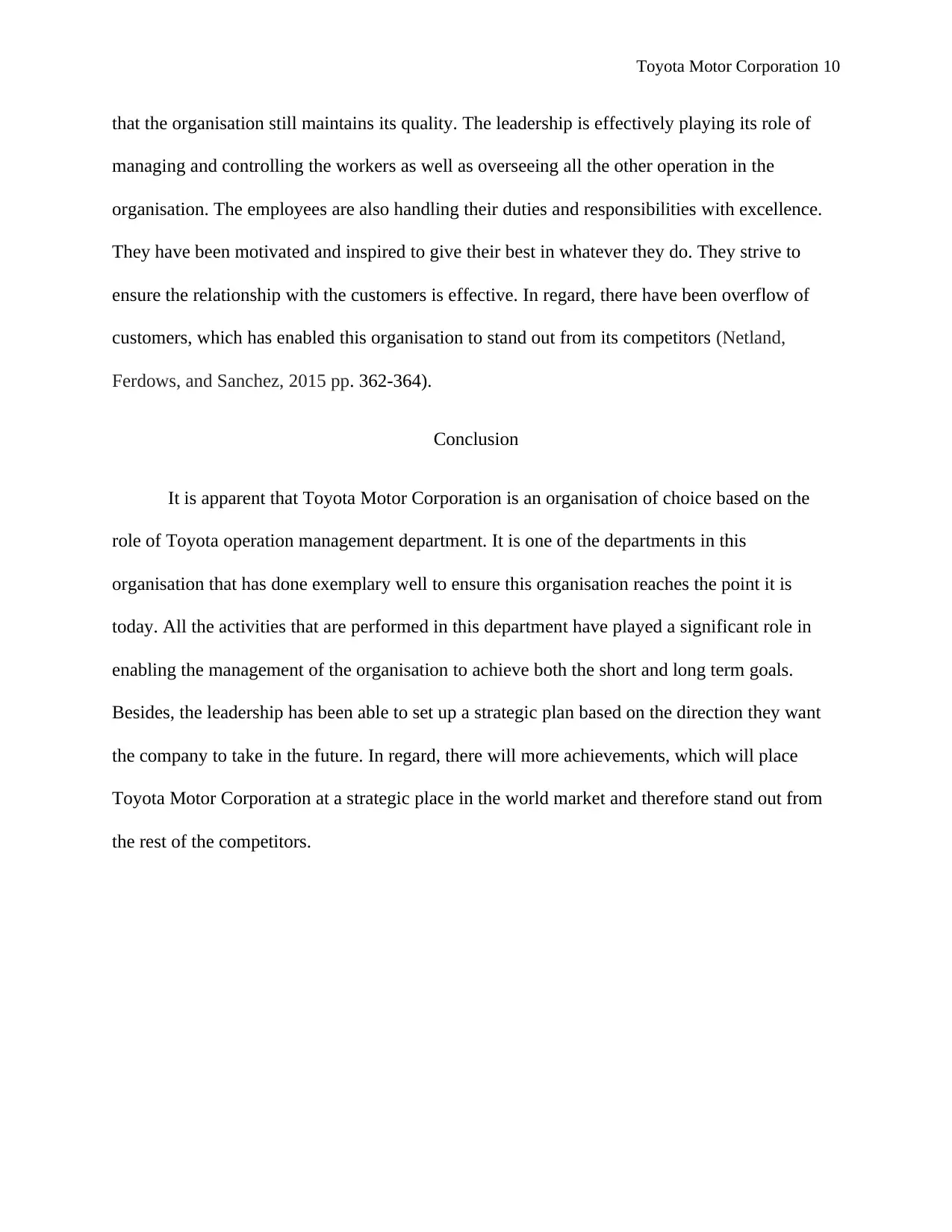
Toyota Motor Corporation 10
that the organisation still maintains its quality. The leadership is effectively playing its role of
managing and controlling the workers as well as overseeing all the other operation in the
organisation. The employees are also handling their duties and responsibilities with excellence.
They have been motivated and inspired to give their best in whatever they do. They strive to
ensure the relationship with the customers is effective. In regard, there have been overflow of
customers, which has enabled this organisation to stand out from its competitors (Netland,
Ferdows, and Sanchez, 2015 pp. 362-364).
Conclusion
It is apparent that Toyota Motor Corporation is an organisation of choice based on the
role of Toyota operation management department. It is one of the departments in this
organisation that has done exemplary well to ensure this organisation reaches the point it is
today. All the activities that are performed in this department have played a significant role in
enabling the management of the organisation to achieve both the short and long term goals.
Besides, the leadership has been able to set up a strategic plan based on the direction they want
the company to take in the future. In regard, there will more achievements, which will place
Toyota Motor Corporation at a strategic place in the world market and therefore stand out from
the rest of the competitors.
that the organisation still maintains its quality. The leadership is effectively playing its role of
managing and controlling the workers as well as overseeing all the other operation in the
organisation. The employees are also handling their duties and responsibilities with excellence.
They have been motivated and inspired to give their best in whatever they do. They strive to
ensure the relationship with the customers is effective. In regard, there have been overflow of
customers, which has enabled this organisation to stand out from its competitors (Netland,
Ferdows, and Sanchez, 2015 pp. 362-364).
Conclusion
It is apparent that Toyota Motor Corporation is an organisation of choice based on the
role of Toyota operation management department. It is one of the departments in this
organisation that has done exemplary well to ensure this organisation reaches the point it is
today. All the activities that are performed in this department have played a significant role in
enabling the management of the organisation to achieve both the short and long term goals.
Besides, the leadership has been able to set up a strategic plan based on the direction they want
the company to take in the future. In regard, there will more achievements, which will place
Toyota Motor Corporation at a strategic place in the world market and therefore stand out from
the rest of the competitors.
Paraphrase This Document
Need a fresh take? Get an instant paraphrase of this document with our AI Paraphraser
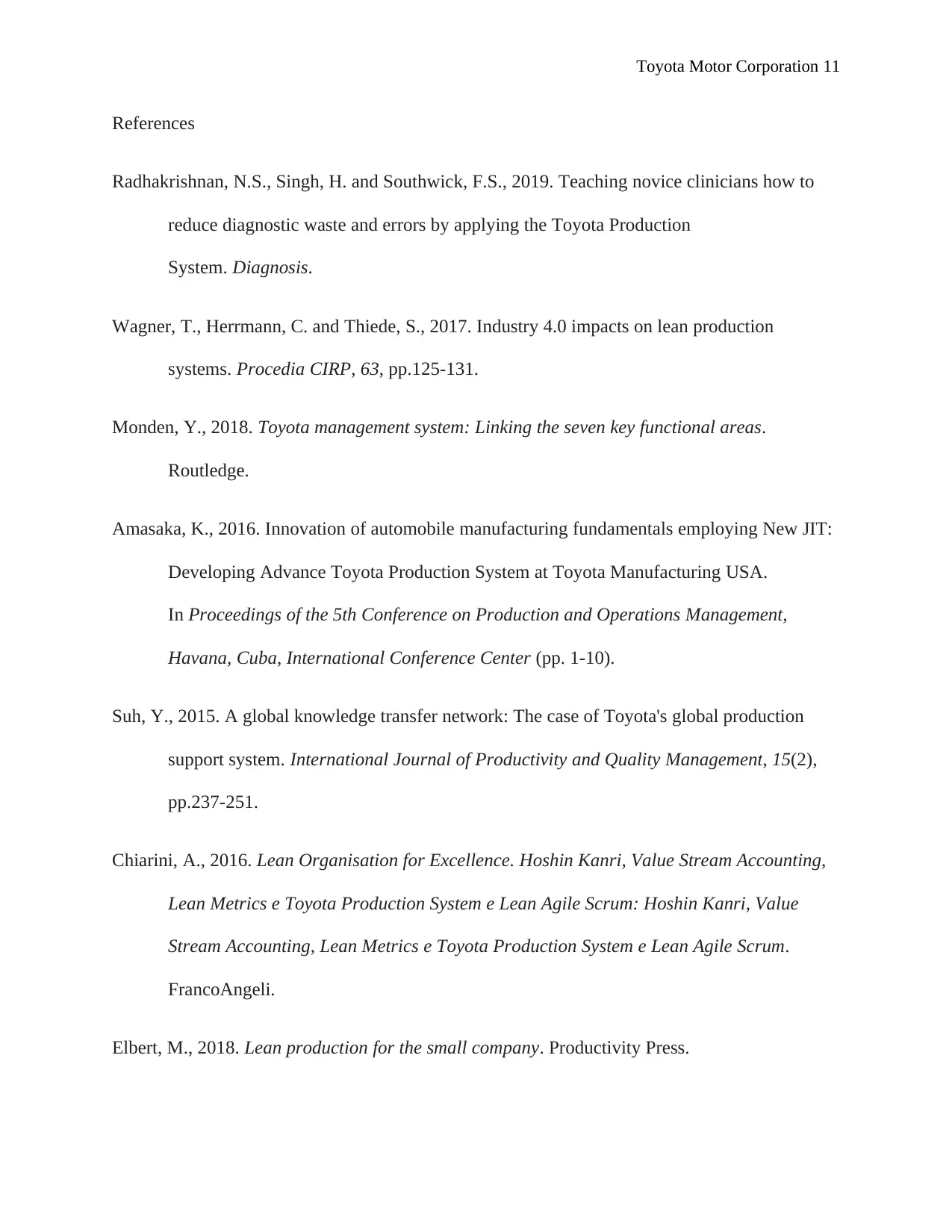
Toyota Motor Corporation 11
References
Radhakrishnan, N.S., Singh, H. and Southwick, F.S., 2019. Teaching novice clinicians how to
reduce diagnostic waste and errors by applying the Toyota Production
System. Diagnosis.
Wagner, T., Herrmann, C. and Thiede, S., 2017. Industry 4.0 impacts on lean production
systems. Procedia CIRP, 63, pp.125-131.
Monden, Y., 2018. Toyota management system: Linking the seven key functional areas.
Routledge.
Amasaka, K., 2016. Innovation of automobile manufacturing fundamentals employing New JIT:
Developing Advance Toyota Production System at Toyota Manufacturing USA.
In Proceedings of the 5th Conference on Production and Operations Management,
Havana, Cuba, International Conference Center (pp. 1-10).
Suh, Y., 2015. A global knowledge transfer network: The case of Toyota's global production
support system. International Journal of Productivity and Quality Management, 15(2),
pp.237-251.
Chiarini, A., 2016. Lean Organisation for Excellence. Hoshin Kanri, Value Stream Accounting,
Lean Metrics e Toyota Production System e Lean Agile Scrum: Hoshin Kanri, Value
Stream Accounting, Lean Metrics e Toyota Production System e Lean Agile Scrum.
FrancoAngeli.
Elbert, M., 2018. Lean production for the small company. Productivity Press.
References
Radhakrishnan, N.S., Singh, H. and Southwick, F.S., 2019. Teaching novice clinicians how to
reduce diagnostic waste and errors by applying the Toyota Production
System. Diagnosis.
Wagner, T., Herrmann, C. and Thiede, S., 2017. Industry 4.0 impacts on lean production
systems. Procedia CIRP, 63, pp.125-131.
Monden, Y., 2018. Toyota management system: Linking the seven key functional areas.
Routledge.
Amasaka, K., 2016. Innovation of automobile manufacturing fundamentals employing New JIT:
Developing Advance Toyota Production System at Toyota Manufacturing USA.
In Proceedings of the 5th Conference on Production and Operations Management,
Havana, Cuba, International Conference Center (pp. 1-10).
Suh, Y., 2015. A global knowledge transfer network: The case of Toyota's global production
support system. International Journal of Productivity and Quality Management, 15(2),
pp.237-251.
Chiarini, A., 2016. Lean Organisation for Excellence. Hoshin Kanri, Value Stream Accounting,
Lean Metrics e Toyota Production System e Lean Agile Scrum: Hoshin Kanri, Value
Stream Accounting, Lean Metrics e Toyota Production System e Lean Agile Scrum.
FrancoAngeli.
Elbert, M., 2018. Lean production for the small company. Productivity Press.
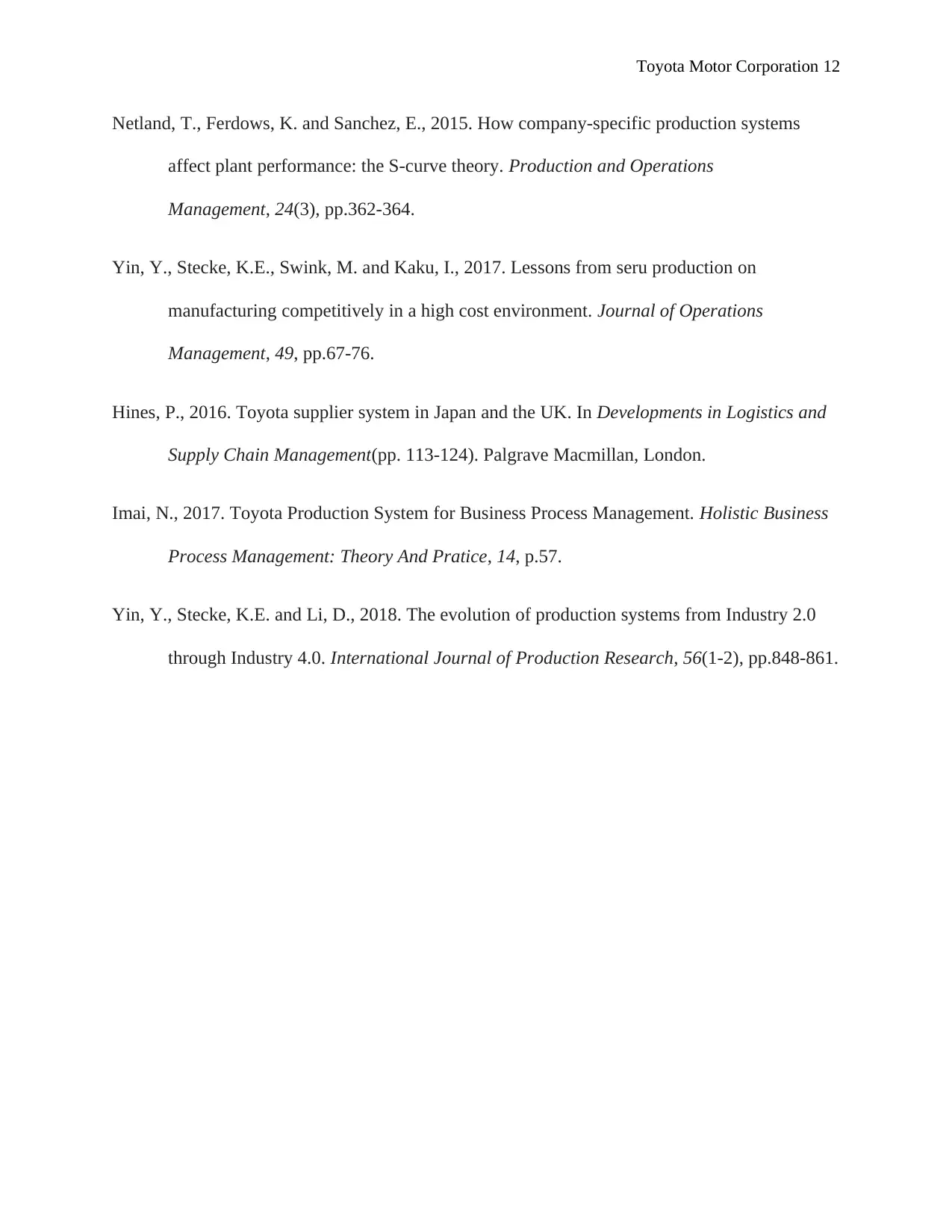
Toyota Motor Corporation 12
Netland, T., Ferdows, K. and Sanchez, E., 2015. How company-specific production systems
affect plant performance: the S-curve theory. Production and Operations
Management, 24(3), pp.362-364.
Yin, Y., Stecke, K.E., Swink, M. and Kaku, I., 2017. Lessons from seru production on
manufacturing competitively in a high cost environment. Journal of Operations
Management, 49, pp.67-76.
Hines, P., 2016. Toyota supplier system in Japan and the UK. In Developments in Logistics and
Supply Chain Management(pp. 113-124). Palgrave Macmillan, London.
Imai, N., 2017. Toyota Production System for Business Process Management. Holistic Business
Process Management: Theory And Pratice, 14, p.57.
Yin, Y., Stecke, K.E. and Li, D., 2018. The evolution of production systems from Industry 2.0
through Industry 4.0. International Journal of Production Research, 56(1-2), pp.848-861.
Netland, T., Ferdows, K. and Sanchez, E., 2015. How company-specific production systems
affect plant performance: the S-curve theory. Production and Operations
Management, 24(3), pp.362-364.
Yin, Y., Stecke, K.E., Swink, M. and Kaku, I., 2017. Lessons from seru production on
manufacturing competitively in a high cost environment. Journal of Operations
Management, 49, pp.67-76.
Hines, P., 2016. Toyota supplier system in Japan and the UK. In Developments in Logistics and
Supply Chain Management(pp. 113-124). Palgrave Macmillan, London.
Imai, N., 2017. Toyota Production System for Business Process Management. Holistic Business
Process Management: Theory And Pratice, 14, p.57.
Yin, Y., Stecke, K.E. and Li, D., 2018. The evolution of production systems from Industry 2.0
through Industry 4.0. International Journal of Production Research, 56(1-2), pp.848-861.
⊘ This is a preview!⊘
Do you want full access?
Subscribe today to unlock all pages.

Trusted by 1+ million students worldwide
1 out of 12
Related Documents
Your All-in-One AI-Powered Toolkit for Academic Success.
+13062052269
info@desklib.com
Available 24*7 on WhatsApp / Email
![[object Object]](/_next/static/media/star-bottom.7253800d.svg)
Unlock your academic potential
Copyright © 2020–2025 A2Z Services. All Rights Reserved. Developed and managed by ZUCOL.





